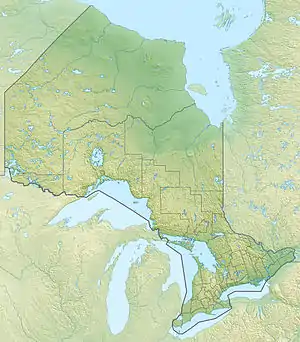Larder Lake
Larder Lake is a freshwater lake in Timiskaming District in Northeastern Ontario, Canada.[1][2][3][4] The lake straddles the incorporated (municipal) townships of Larder Lake and McGarry and geographic McFadden Township. It is part of the Saint Lawrence River drainage basin and is the source of the Larder River.
| Larder Lake | |
|---|---|
 | |
 Larder Lake Location in Ontario | |
| Location | Timiskaming District, Ontario |
| Coordinates | 48°05′07″N 79°38′32″W[1] |
| Type | Lake |
| Part of | Saint Lawrence River drainage basin |
| Primary outflows | Larder River |
| Basin countries | Canada |
| Max. length | 12.5 kilometres (7.8 mi) |
| Max. width | 6.3 kilometres (3.9 mi) |
| Surface elevation | 274 metres (899 ft) |
Geography
Larder lake has two large arms, Southwest Arm and Northeast Arm, and four bays: Fitzpatrick Bay in the southwest; and Dublin Bay, Northwest Bay and Spoon Bay at the northwest. A 5.5-kilometre (3.4 mi) long peninsula extends in the middle of the lake from south to north up to the Big Narrows, separating the lake into two parts. The major islands include Big Pete Island, Island CC and Island U.
Larder Lake has five named inflows: Sharp Creek and Benson Creek at the southwest; Pancake Creek to Northwest Bay; Bear Creek to the tip of Northeast Arm; and Milky Creek at the east. The primary outflow is the Larder River, at the southeast, which flows via the Blanche River, Lake Timiskaming and the Ottawa River to the Saint Lawrence River.
The community of Larder Lake (in the eponymous municipal township of Larder Lake) is located on the northwest shore of Spoon Bay, and the communities of Viginiatown and Kearns, both part of municipal McGarry township, are located at the northeast end of Northeast Arm.
Ontario Highway 66 travels in an east-west direction along the north side of the lake, and Ontario Highway 624 travels in a north-south direction along on the west side of the lake.
Economy
Forestry and recreational tourism are the main economic activities in the lake area.
Climate
The lake surface is generally frozen from mid-November to late April; however, the period of safe ice circulation is usually from mid-December to mid-April.
References
- "Larder Lake". Geographical Names Data Base. Natural Resources Canada. Retrieved 2017-12-17.
- "CLAIMaps IV". Ontario Ministry of Northern Development and Mines. 2016. Retrieved 2017-12-17.
- Map 15 (PDF) (Map). 1 : 1,600,000. Official road map of Ontario. Ministry of Transportation of Ontario. 2016-01-01. Retrieved 2017-12-17.
- Restructured municipalities - Ontario map #4 (Map). Restructuring Maps of Ontario. Ontario Ministry of Municipal Affairs and Housing. 2006. Retrieved 2017-12-17.